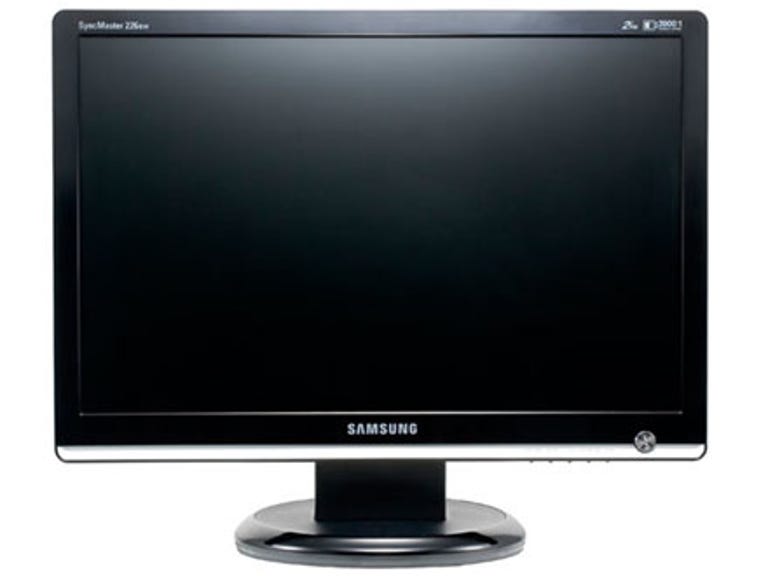 Why You Can Trust CNET
Why You Can Trust CNET Samsung SyncMaster 226BW review: Samsung SyncMaster 226BW
Given its gaming credentials, it's no surprise the Samsung SyncMaster 226BW is best for games, but it's expensive and feature-poor.
The Samsung SyncMaster 226BW is a 22-inch widescreen LCD with some impressive gaming credentials -- it's the official monitor of the World Cyber Games, which had a meet in Sydney recently.
The Good
The Bad
The Bottom Line
With LCD prices currently in a freefall, is now a good time to buy an LCD? And is this Samsung the one to get -- especially with its gaming affiliations?
Design
One aspect of the Samsung's design which we didn't appreciate was the placement of the control buttons. They are situated close together on underside of the bezel, which makes it very easy to hit the wrong button.
Features
In order to tailor the screen to your needs, the Samsung comes with seven different picture modes, including a custom mode. As we found, images in most modes were bright, and featured sharp text and good contrast. Although, as you'll see, we did find the screen difficult to calibrate.
For a monitor hovering towards a grand, the Samsung boasts remarkably few features. Asus' PG221 is the same price and boasts a gaggle of analog inputs. Similarly, the Dell 2407WFP-HC may be larger at 24-inches but is regularly available for AU$999 online, and also features plenty of inputs and a card reader. Of course, the street price of the Samsung is considerably lower than retail -- the best price we've seen was around AU$450. When viewed in this light it's a remarkably better offering.
Performance
That claimed 3000:1 contrast ratio was, of course, pretty much bunkum -- most plasmas, for example, can only manage around 4000:1 -- and we believe this refers to the dedicated "dynamic contrast" mode. This works like an iris in a projector making the screen darker during blacker scenes. However, black levels are pretty good for a screen of this size, and there was certainly no light leakage from the sides, as we saw with the Asus.
Using our DisplayMate test suite, we quickly found that colour uniformity was not one of the SyncMaster's stronger points. Pure colours had a tendency to be darker at the top of the screen than the bottom, especially when displaying blue or red. Not a screen for graphics professionals, then.
Where the screen did excel was in its display of high contrast images, as well as text which was incredibly sharp. This widescreen 22-inch screen is perfect for productivity applications, as the sheer amount of real estate allows browser tabs and side-by-side windows to spread their wings.
As is this monitor's wont, we spent quite some time testing the SyncMaster 226BW with a healthy selection of games, and the results were mostly excellent. Best of all was one of our favourite online shooters, Battlefield 2142. It looked simply fantastic on this high-contrast screen. There were no traces of lag and, for a game with such a muted palette, colours were the deepest and richest we'd seen.
Darker, more atmospheric games were a mixed bag, though. For example, while it's not the most graphically advanced game, S.T.A.L.K.E.R.: Shadow of Chernobyl looked very good on the Samsung, with a decent amount of contrast and faithful colour reproduction.
Not so effective was another shoot-and-shocker, the brand new ="" class="c-regularLink" target="_blank" rel="noopener nofollow">Bioshock. This is a very dark game, and the Samsung found it difficult to communicate the detail in an effective way. Though there is a dedicated "Game" mode on the Samsung, this tended to overblow the images so that shadows came out looking green and slimy, like seaweed drying in the sun.
To this end, we had a lot of trouble trying to calibrate the Samsung. We found it difficult to set the monitor to a level where we were completely happy with the images produced -- we found we had to manipulate our graphics card settings as well. Dynamic contrast is possibly the best mode for most purposes, though it can get a little too dark for effective gameplay in darker games.
Movie watching, on the other hand, was mostly good. Lord of the Rings: The Fellowship of the Ring was reproduced well in most situations, though darker scenes tended to lose detail. But it's certainly a step up from the LCDs on most notebooks today.


